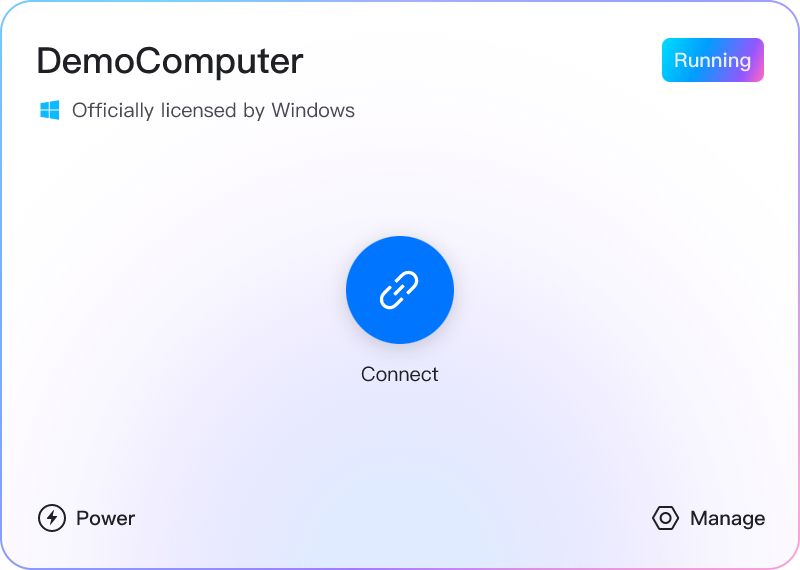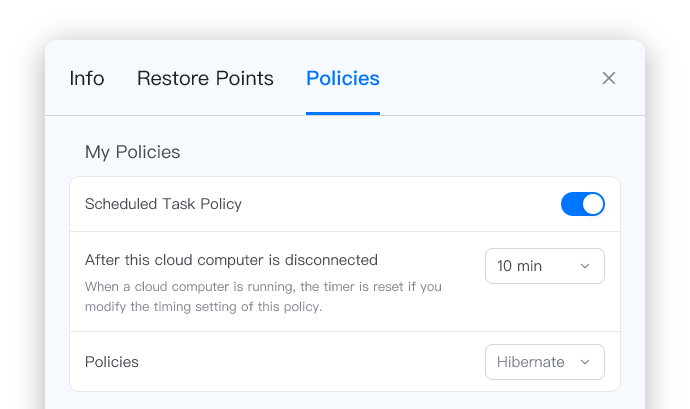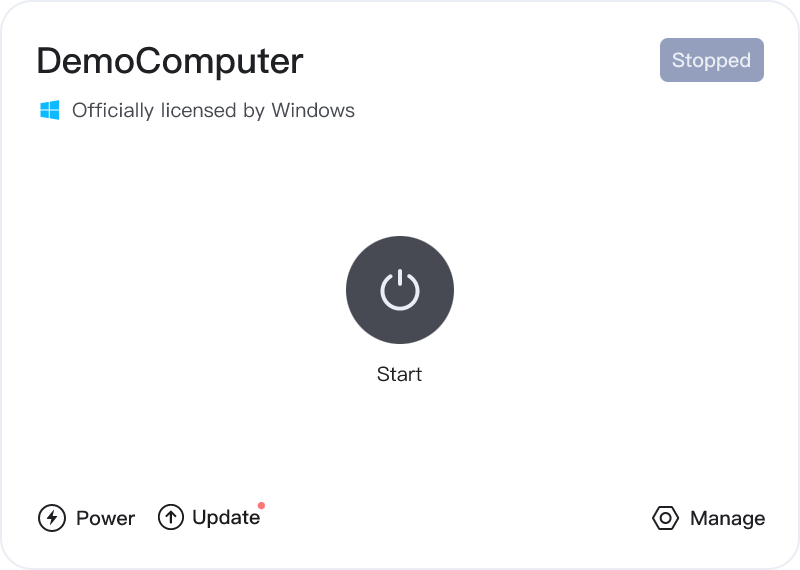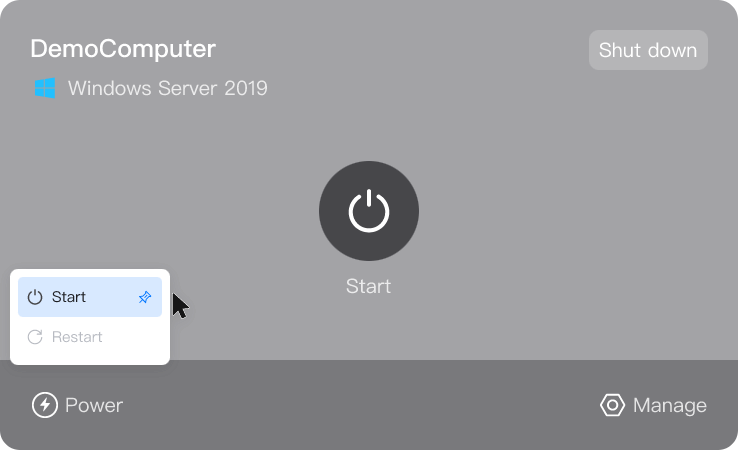After you log on to an Alibaba Cloud Workspace terminal, cloud computers that are assigned to you are displayed as cards or icons. You can view the status of cloud computers and perform basic operations on the cards. This topic describes the common management options provided on the cards.
In this topic, the Windows client of Alibaba Cloud Workspace V7.7 is used as an example. If the actual scenario differs from the description in this topic, it may be because you are using an Alibaba Cloud Workspace client rather than Windows client or your client is outdated. We recommend that you update your client to the latest version.
Prerequisites
You are logged on to an Alibaba Cloud Workspace terminal. For more information, see Getting started.
A cloud computer is assigned to you. For more information, see Assign cloud computers to users.
Connect to or disconnect from a cloud computer
Connect to a cloud computer
If Running appears in the upper-right corner of the card of a cloud computer, click Connect.

If In Use appears in the upper-right corner of the card of a cloud computer, click Show Window to go to the desktop of the cloud computer.
After you log on to the terminal, if only one cloud computer exists within your account, the cloud computer is automatically connected. If you want to cancel the automatic connection feature, click the icon on the cloud resource page, select Security, click the Sign-in Security tab, and then modify the settings in the Auto-connect Sole Cloud Computer section. For more information, see Automatically connect to a cloud computer.
Disconnect from a cloud computer
If you no longer use a cloud computer and want to disconnect from it, perform the following operations:
If the cloud computer is not in full-screen mode, click the icon.
Click DesktopAssistant and then click Disconnect.
Manage power options
You can start, stop, restart, and hibernate cloud computers in a similar manner as physical computers by using the options provided on the cloud computer cards.
Start a cloud computer
If the card of a cloud computer is dimmed and Stopped is displayed in the upper-right corner of the card, click Start. After you start the cloud computer, Running appears in the upper-right corner of the card.

Stop a cloud computer
If you stop a cloud computer, running processes terminate and unsaved data may be lost. Before you stop a cloud computer, make sure that data is saved or backed up.
You can use one of the following methods to stop a cloud computer:
Directly stop a cloud computer
Stop an Adaptive Streaming Protocol (ASP)-based Windows cloud computer by using DesktopAssistant
Open DesktopAssistant, click Shut Down, and then click OK.
Stop a cloud computer by using the options provided on the cloud resource page Disconnect from the cloud computer. Then, on the card of the cloud computer, choose and click OK.
NoteIf you use the web client to connect to the cloud computer, you can only use the option provided on the card to stop the cloud computer.
Create a scheduled stop policy
You can create a scheduled policy to automatically stop a cloud computer after the cloud computer is disconnected for a specific period of time.
On the card of the cloud computer for which you want to configure a scheduled stop policy, click Manage and then Policies.
In the Scheduled Task Policy section of the Policies panel, specify a value for the After this cloud computer is disconnected parameter and select Shut Down from the Policies drop-down list.
 Note
NoteIf the administrator prohibits you from modifying the policy, the settings in this panel are read-only and cannot be modified.
Restart a cloud computer
If you restart a cloud computer, running processes terminate and unsaved data may be lost. Before you restart a cloud computer, make sure that data is saved or backed up.
To restart a cloud computer, you can use one of the following methods:
Restart a cloud computer by using DesktopAssistant
Open DesktopAssistant, click Restart, and then click OK. This method takes effect only for ASP-based cloud computers.
Restart a cloud computer by using the options provided on the cloud resource page Disconnect from the cloud computer. Then, on the card of the cloud computer, choose and click OK.
NoteIf you use the web client, you can only use the option provided on the card to restart the cloud computer.
Hibernate a cloud computer
When a cloud computer is hibernated, all files and processes on the cloud computer are saved. You can wake up the cloud computer from hibernation to resume your work at any time.
You cannot hibernate High Frequency or Graphics cloud computers.
The Hibernate operation is not supported in the following regions:
China (Nanjing - Local Region)
China (Fuzhou - Local Region)
Philippines (Manila)
SAU (Riyadh - Partner Region)
If a cloud computer hibernates for 15 days, the cloud computer is automatically stopped. We recommend that you save the data on the cloud computer at the earliest opportunity.
You can hibernate cloud computers that are in the Running or In Use state. You cannot create restore points for cloud computers that are in the Hibernated state.
Directly hibernate a cloud computer
On the card of the cloud computer that you want to hibernate, choose .
If you use a method other than the web client to connect to a Windows cloud computer that uses the ASP protocol, open DesktopAssistant and choose .
In the message that appears, click Hibernate Now.
NoteAfter the cloud computer is hibernated, Hibernated appears in the upper-right corner of the corresponding card. Move your pointer over the card and click Connect to wake up the cloud computer. You must wait for approximately 30 seconds to wake up a cloud computer.
Create a scheduled hibernation policy
You can create a scheduled policy to automatically hibernate a cloud computer after the cloud computed is disconnected for a specific period of time.
On the card of the cloud computer for which you want to configure a scheduled hibernation policy, click Manage and then Policies.
In the Scheduled Task Policy section of the My Policies panel, specify a value for the After this cloud computer is disconnected parameter and select Hibernate from the Policies drop-down list.
 Note
NoteIf the administrator prohibits you from modifying the policy, the settings in this panel are read-only and cannot be modified.
Update Alibaba Cloud Workspace components of a cloud computer
To resolve issues related to cloud computers and improve user experience, you can update Alibaba Cloud Workspace components. When updates are available, the Update option appears on the cards of cloud computers.
Before you update a cloud computer, make sure that files on the cloud computer are saved.
An update requires 10 to 15 minutes to complete, during which the cloud computer is unavailable.
Find the cloud computer that you want to update and click Update on its card.
In the dialog box that appears, click Update Now.
You can also click Select Start Time and select Update in 4 hours, Update in 8 hours, or Update in 12 hours based on your business requirements.
In the message that appears, click Confirm Update.
In the Updated dialog box that appears, click Got it.
If you cannot connect to the cloud computer or want to roll back the cloud computer after the update, perform the following operations: Click Manage on the card, choose , click the restore point of the system disk or data disk that is created at the point in time to which you want to restore the cloud computer, and then click Confirm Restore. You can also contact your enterprise IT administrator to obtain technical support.
If you fail to update the cloud computer, retry or contact your enterprise IT administrator.
Specify a custom name for a cloud computer
You can specify custom names for cloud computers to facilitate identification and query.
In the lower-right corner of the card, click Manage.
On the Info tab, click Edit next to Custom Name, specify a name for the cloud computer, and then click OK.
NoteThe name must be 2 to 24 characters in length, and can contain letters, digits, colons (:), underscores (_), periods (.), and hyphens (-). The name must start with a letter.
What to do next
Pin a power option. You can click Power on the card of a cloud computer and click the icon to pin a power option that you frequently use. Then, the pinned option is displayed next to Power. You can pin only one power option. You can also unpin a pinned option.

Configure preference settings. After you connect to a cloud computer, you can configure preference settings based on your business requirements. For more information, see Configure preference settings.
Configure scheduled stop or hibernation tasks. After a cloud computer is disconnected, it keeps running. You can configure a scheduled stop or hibernation policy to automatically stop or hibernate cloud computers after disconnection. For more information, see Configure a scheduled policy for a cloud computer.